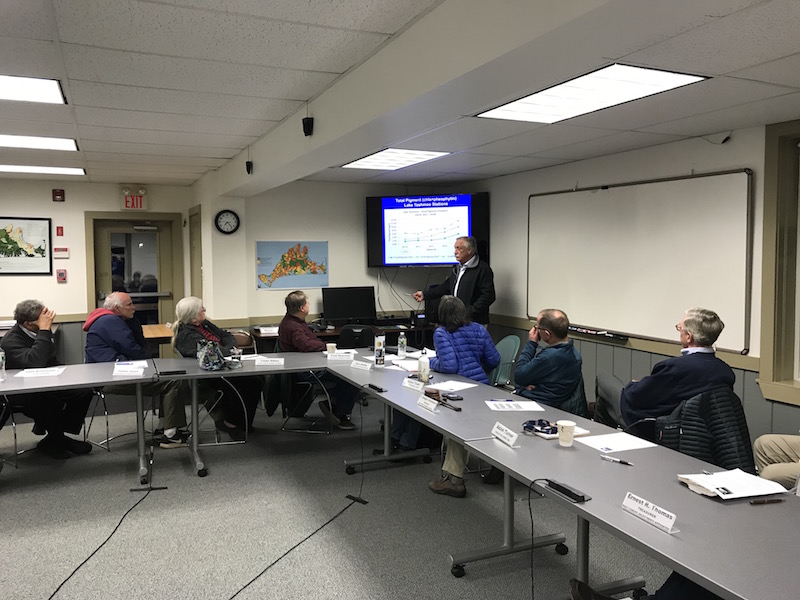Three years ago, the Martha’s Vineyard Commission began monitoring the Island’s coastal ponds and estuaries to study the water quality of the fragile ecosystems.
Last Thursday, the results of the study were presented by Dr. Brian Howes of the University of Massachusetts Dartmouth.
The statistics were mixed, revealing both continued high levels of nitrogen in some ponds and improvement in others.
“We’re at a tipping point,” MVC executive director Adam Turner said. “We could go in either direction. We could get better, and we’ve put a lot of work in, but a lot of work still needs to be done.”
Mr. Howes, the technical lead on the project, showed maps of the testing sites on the 13 different Island ponds. According to Mr. Howes, the most telling variables about the health of the pond are its nitrogen levels, although he said the nitrogen itself isn’t the issue.

“Nitrogen is important, but it is only a yardstick,” Dr. Howes said. “We don’t really care about the actual nitrogen. We care about all the resources that use the estuaries.”
These resources include birds, fish, shellfish, eelgrass and clean water.
Mr. Howes said results from the testing showed that almost all of the ponds had some level of over-nitrogenization, generally caused by deforestation and underground septic tanks, but that it often differs based upon particular ponds and particular locations within ponds.
“Most of the estuaries on Martha’s Vineyard are showing some level of impairment,” Dr. Howes said. “But an estuary is not a box. It has a gradient. There’s better water quality at the inlet, and it degrades toward the headwaters. That’s where most nitrogen enters, and has the least flushing.”
A map of Lake Tashmoo, for instance, showed high nitrogen levels at the head and lower ones closer to the sound, where the pond water exchanges with the sea. Mr. Howes said that while Tashmoo’s levels were historically better than those from 2016, he couldn’t confirm it represented a real change in the health of the basin.
“It is right on the edge,” he said. “Not horrible, not great. That’s the trend you see in this system.”
Other ponds had better results.
“Farm Pond was one of the happiest systems we looked at,” Mr. Howes said. While he found eelgrass in the pond (a traditional sign of good health), he described the epiphytes — or non-parasitic growth on the plants — as looking like a “hairy wand.”
“If you replace the culverts, this system will be fully restored,” Dr. Howes said. “The solution is in hand . . . this is super low-hanging fruit.”
Mr. Howes also described Menemsha and Edgartown Great Ponds as success stories, mainly because of dredging and strategic shoreline openings that led to nitrogen flushing. Others, he said, were in a more dire state. Testing showed Tisbury Great Pond was a uniformly poor and moderately impaired system.
“Chlorophyll levels are quite high. Very high nitrogen levels as well,” Mr. Howes said. “There’s no permanent inlet so there is nothing to drive better water quality.”
Ponds like Squibnocket and James Pond also fell into that category. Mr. Howes recommended continued monitoring of the ponds, collecting data with automated sensors, monitoring land development, and tracking pond openings — something Mr. Turner said the commission takes seriously.
“We are a leader in strategic pond openings,” Mr. Turner said. “We’re going to be more responsive and get in before the opening and after the opening to collect data.”
The 100-page report is posted on the commission website.
In other business Thursday, the commission’s special projects planner Dan Doyle talked about collecting data on a different Island concern: traffic. He discussed a grant the commission received to place permanent traffic counters at six different locations around the Island. Mr. Doyle hopes to have the counters up and running for the summer.
Mr. Doyle said he hopes to use the data to analyze how far the shoulder seasons extend into the fall and spring, and showcase the effect the summer population has on the Island’s year-round infrastructure. The counters will be buried in small slits beneath the roads, with the data storage boxes connected to utility poles or, in the case of Beach Road, powered by solar energy.
“The wheels are in motion,” Mr. Doyle said.







Comments (4)
Comments
Comment policy »